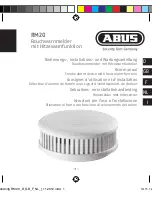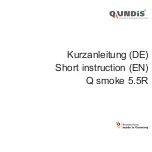
7109CS/CSX & 7109LS
7139CS/CSX & 7139LS
Installation Instructions - Owner's/User's Information Manual
-
READ CAREFULLY & SAVE
INTRODUCTION
The 7139CS/CSX & 7139LS smoke alarms are photoelectric type
alarms for use as an evacuation device in commercial and commercial
residential applications, while the 7109CS/CSX & 7109LS are for use
as an alert and relocate device. Each smoke alarm has a solid state
piezo to warn and alert the household to the presence of threatening
smoke as well as a visual signal to warn and alert the hearing
impaired to the presence of threatening smoke.
Your photoelectric smoke alarm is designed to detect the smoke
that results from an actual fire. Consequently, it is uncommon for
household smoke such as cigarette smoke or normal cooking smoke
to cause an alarm.
BASIC SAFETY INFORMATION
Dangers, Warnings, Cautions and Notices alert you to important
operating procedures or to potentially hazardous situations. Pay
special attention to these items.
WARNING!
This photoelectric smoke alarm is listed for use in single-family and
multi-family residences, along with hotels, motels and other
commercial residential occupancies.
This photoelectric smoke alarm must receive continuous 120VAC,
60Hz , pure sine wave electrical power.
NEVER ignore your smoke alarm if it sounds. Refer to IF YOUR
SMOKE ALARM SOUNDS section for more information. Failure to
do so can result in serious injury or death.
Test this device once a week per manufacturer installation
recommendation. If the device ever fails to test correctly, replace
immediately! If the device is not working properly, it can not alert you
to a problem.
This product is intended for use in indoor locations of family dwelling
units.
MODELS
*7109CS/CSX-W or C.....120VAC, 60Hz with 1 Form C Aux. relay
contact and visual signal with tandem wire
connection. CSX model is provided with an
additional wire (grey) for the remote
activation of the visual signal.
*7109LS.......................... 120VAC, 60Hz wall mounted, provided
with a 9 foot line cord, pulsating horn and
visual signal.
**7139CS/CSX-W or C....Same as the 7109CS but with a temporal
horn. CSX model is provided with an
additional wire (grey) for the remote
activation of the visual signal.
**7139LS........................ Same as 7109LS but with a temporal horn.
* These units produce a non-temporal audible alarm and are therefore
not intended for locations where the desired action of the occupant(s)
is evacuation.
** Per NFPA 72, the
American National Standard Audible Emergency
Evacuation Signal
as defined in ANSI S3.41, is required whenever
the intended response is to evacuate the building.
NOTICE:
Visual signals are only one method of alerting the hearing impaired.
Not all hearing impaired individuals will be alerted by visual signals.
NOTICE:
Loss of electrical input will cause the smoke alarm not to function. For
maximum safety you should install both battery operated and AC powered
smoke alarms.
ELECTRICAL SPECIFICATIONS
OPERATING VOLTAGE. . . . . . . . . . . . . . . . . . . . . . . 120VAC, 60Hz
OPERATING CURRENT (PEAK). . . . . . . . . . . . . . . . . 0.400 amps
OPERATING AMBIENT TEMPERATURE RANGE . . . . 40
O
F to 100
O
F
ALARM HORN RATING. . . . . . . . . . . . . . . . . . . . . . . .90dBA at 10ft
Under normal conditions, the light generated by the pulsing
infrared LED is not seen by the light sensor, as it is positioned out of
the direct path of the light beam. When smoke enters the sensing
chamber, light from the pulsing LED light source is reflected by the
smoke particles onto the photodiode light sensor. At the first sighting
of smoke, the smoke alarm is put into a pre-alarm mode. This is
indicated by a rapidly flashing LED on the face of the smoke alarm.
Once the light sensor confirms smoke for 2 consecutive pulses inside
the chamber, the light sensor produces the signal necessary to trigger
the smoke alarm.
This technique of verifying the smoke condition, combined with a
5-to-1 signal-to-noise ratio, substantially reduces the possibility of
nuisance alarms.
HOW TO TELL IF YOUR SMOKE ALARM IS WORKING
PROPERLY
Your smoke alarm is provided with an alarm horn and pulsating
Light Emitting (indicator) Diode, which pulses every 15-30 seconds
and a green AC power on LED.
When turning the test knob on the alarm to TEST 1, the red light
will flash rapidly, the horn will sound and the visual signal will flash.
WARNING! Visual signal will not operate without AC power.
If the battery is low or missing, a chirp will be emitted when the red
LED flashes. If the smoke alarm is malfunctioning, the chirp will
sound between the red LED flashes. If AC power fails, the green LED
will turn off.
The test knob of your smoke alarm simulates actual smoke
conditions.
NOTE:
Tandem Interconnect Models.
When testing one smoke alarm, the smoke alarm that is activated
will flash the red indicator light and sound its alarm horn. All other
units will sound the alarm horn with their red indicator lights remaining
off.
FIRE PROTECTION PLAN: WHAT YOU CAN DO TO MAKE
YOUR FAMILY SAFE FROM FIRES
This smoke alarm can quickly alert you to the presence of smoke;
it cannot prevent fire. The ultimate responsibility for fire protection
rests solely on you.
Installing smoke alarms is just the first step in protecting your
family from fires. You also must reduce the chances that fires will start
in your home and increase your chances of safely escaping if one
does start. To have an effective fire safety program:
a. Install smoke alarms properly following the instructions in this
manual. Keep your smoke alarms clean. Test your devices
weekly and have unit repaired or replace unit when it no longer
functions.
As with any electronic product, smoke alarms have a
550-0094
Page 7-1
PHOTOELECTRIC TYPE COMMERCIAL & COMMERCIAL RESIDENTIAL SMOKE ALARMS
FOR THE HEARING IMPAIRED, AC POWERED WITH 9V BATTERY BACKUP
HOW YOUR SMOKE ALARM WORKS
These smoke alarms operate on the photoelectric light scatter
principle. The unit's sensing chamber houses a light source and a
light sensor.
The darkened sensing chamber is exposed to the atmosphere and
designed to permit optimum smoke entry from any direction while
rejecting light from outside the smoke alarm.
The light source is an infrared (invisible) LED which pulses every
4-8 seconds. The light sensor is a photodiode matched to the light
frequency of the LED light source.
























